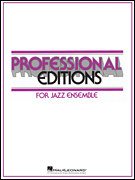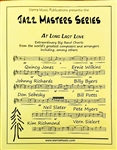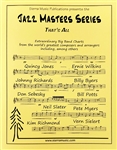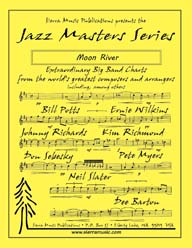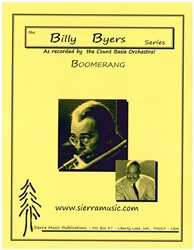ROBOT PORTRAIT [DOWNLOAD]
As Recorded by Quincy Jones
Arranged by Billy Byers, Prepared for Publication by Dylan Canterbury, Rob DuBoff, and Jeffrey Sultanof

Cat #: JLP-7821-DL
$75.00This product is available for immediate download after purchase.
Questions?
Please call +1-518-587-1102 or email us.
Edition: Jazz Big Band Arrangement
Description: Swing - Difficult
Publisher: Jazz Lines Publications
***NEW EDITION FOR 2025 FROM BILLY BYERS'S ORIGINAL SCORE***
Recorded by the Quincy Jones Orchestra for their 1962 album 'The Quintessence,' 'Robot Portrait' is actually an arrangement from the pen of Billy Byers. This jaunty minor blues has some challenging ensemble moments and difficult brass ranges, but is undeniably a blast to both listen to and play.
The introduction starts with a descending riff in the low horns underpinning a simple melody line in the trumpets and tenor saxes before the rest of the ensemble joins them a few measures in. After a screaming trumpet rip, the melody enters at the pickup to measure 9. Carried by a duet of alto sax and trumpet, it is a simple, but extraordinarily catchy riff that is cleverly complimented by some punchy rhythmic figures in the trombones and piano. Melody duties get handed over to the sax section at measure 25 with the brass barking behind them. The saxes and trumpets offer up competing tag lines before another sharp, ripping trumpet line that sets up three choruses of solo tenor saxophone (played on the original recording by Oliver Nelson). Background figures gradually gather behind the tenor solo, starting first with stabbing muted trombones, and eventually adding a trumpet and alto sax riff that is reminiscent of, but not identical to, the melody. Next up is a two chorus trumpet solo (handled originally by Freddie Hubbard). Both choruses feature background figures - first a variation of the main theme in the saxes, followed by some simple rhythmic figures in the trombones.
Said trombone backgrounds actually form the basis of the arrangement's shout chorus, which begins at measure 88. The saxes and brass trade brief, but biting, figures back and forth for two blues choruses. The second chorus (at measure 100) sees the arrangement briefly change from F minor to Bb minor. These two choruses should have a sense of gradual building all the way to the return of the arrangement's original key at measure 112. The saxes play a riff inspired by the main melody, with the brass poking and prodding as they did earlier. Everything culminates in one screaming blast before the melody proper returns at measure 124. There is a slightly extended tag at one point before the introduction is re-used for the arrangement's conclusion at measure 148. The grand finale features a moody brass chord and a brief, somewhat teasing, sax riff.
This arrangement is not a transcription - it has been prepared from a copy of Billy Byers's original manuscript. We have included an alternate 5th trumpet part as a substitute for horn in F.
2 Alto Saxophones
2 Tenor Saxophones
Baritone Saxophone
4 Trumpets
Horn in F (Or Trumpet 5)
4 Trombones
Guitar
Piano
Bass
Drums
Trombone 1: Db5



